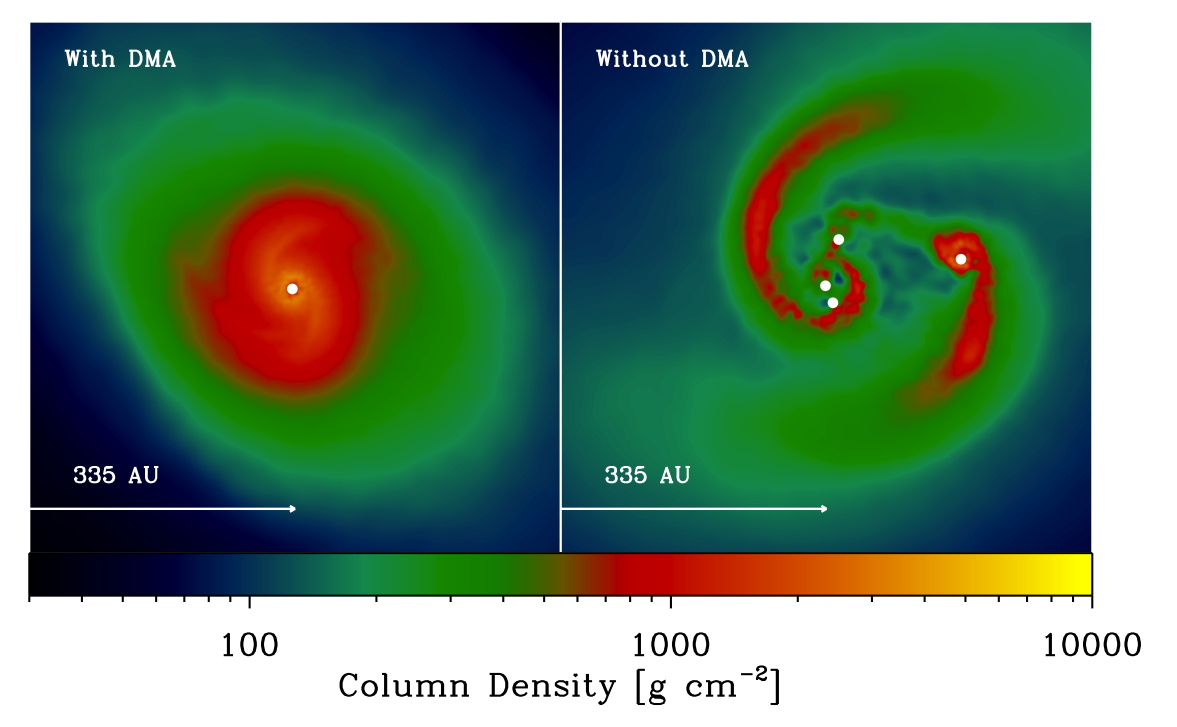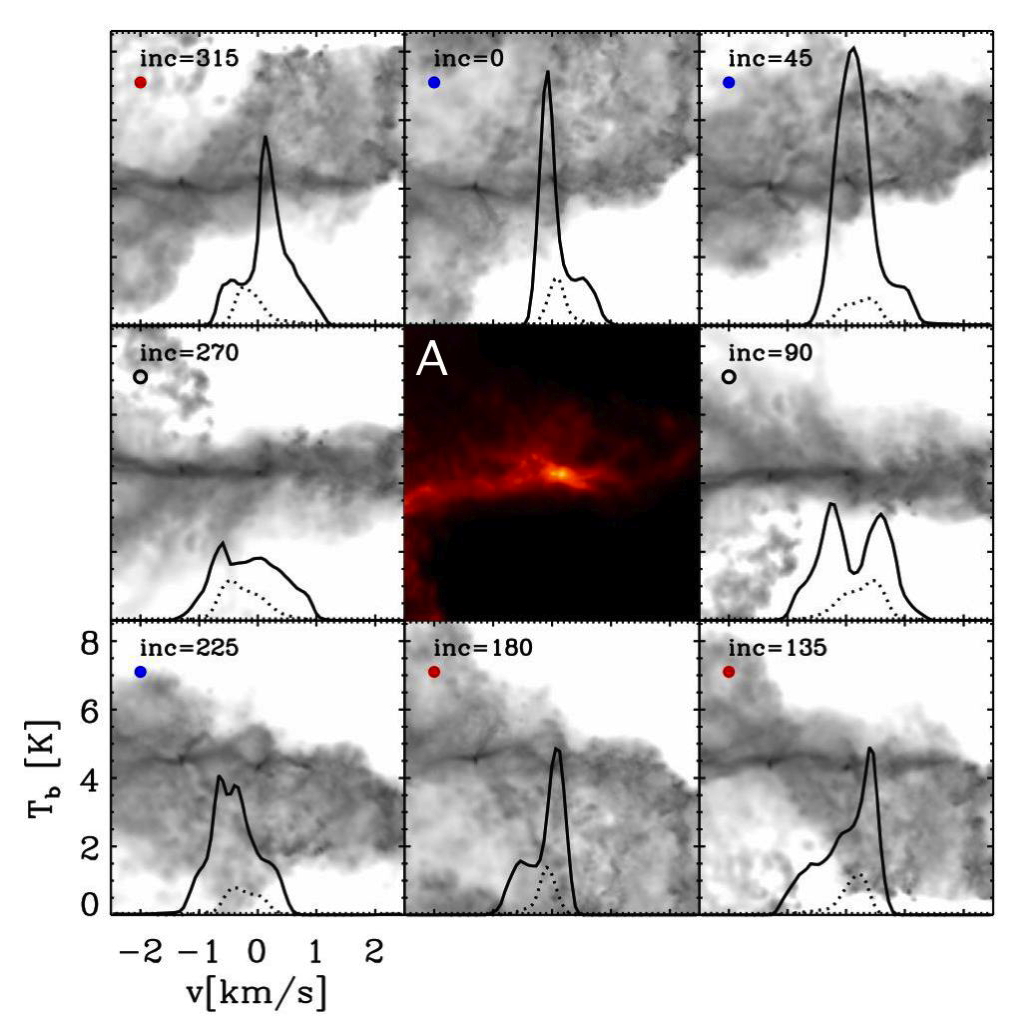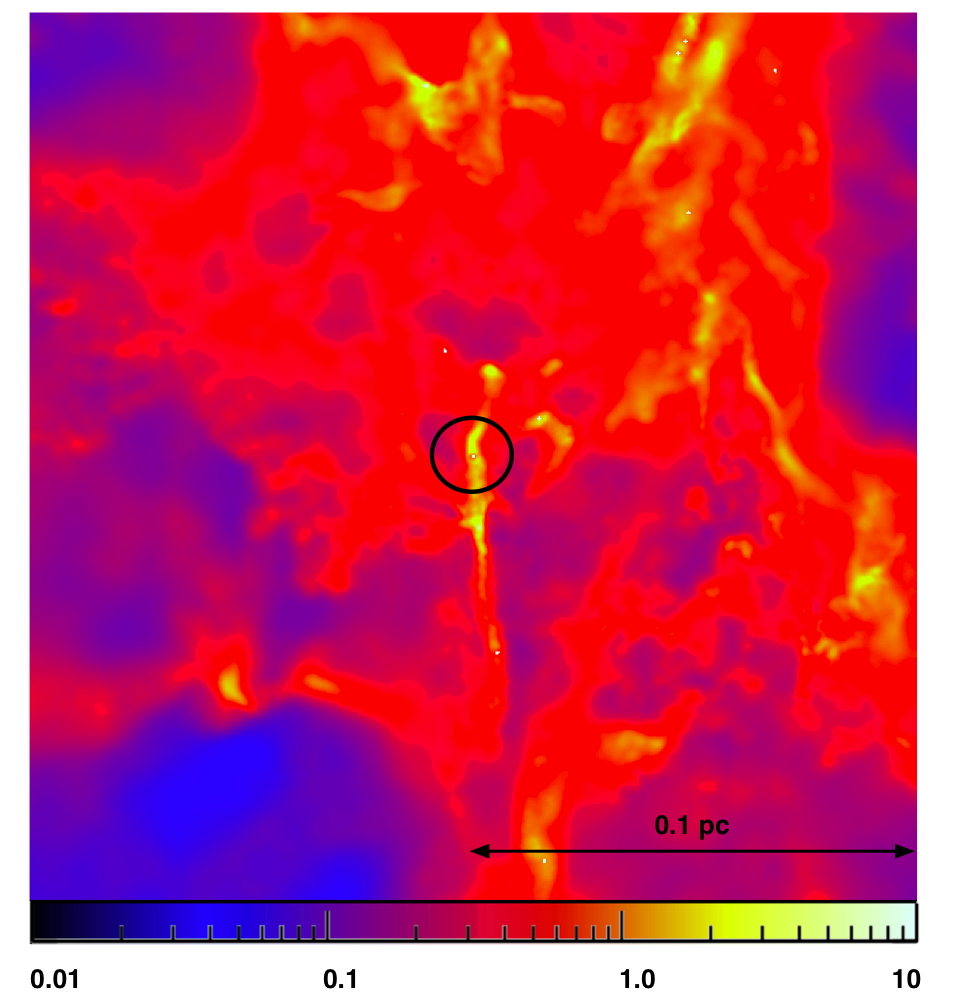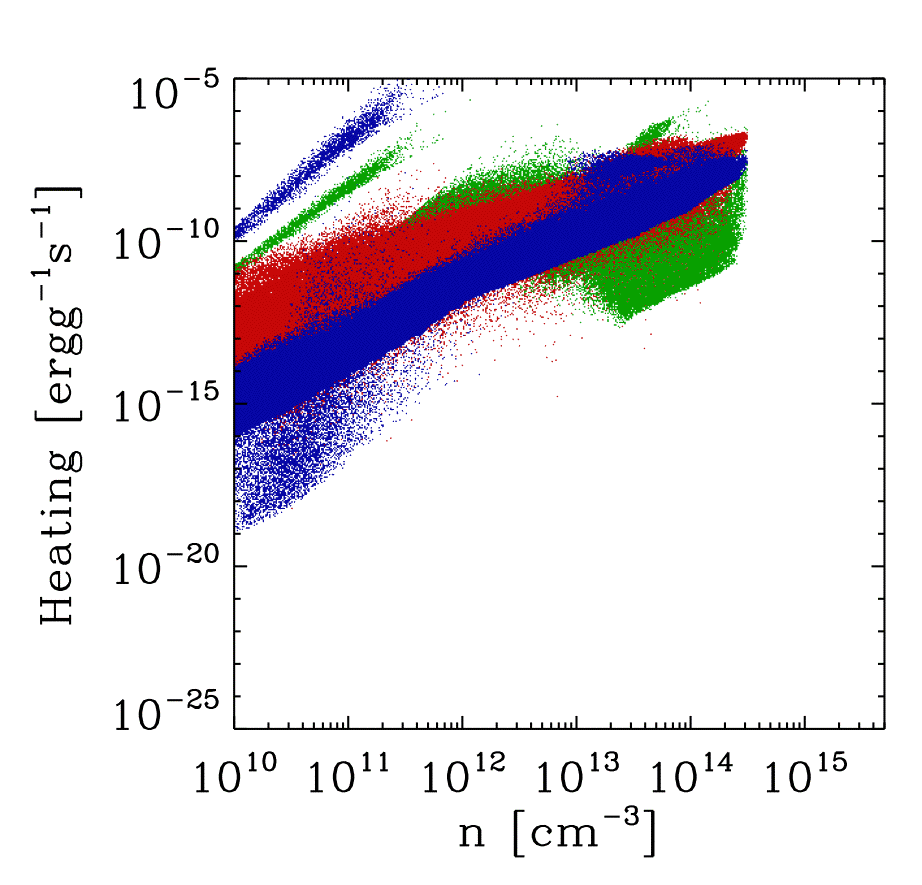My research
WIMP DM and First Stars: Suppression of Fragmentation in Primordial Star Fromation
We present the first three-dimensional simulations to include the effects of dark matter annihilation feedbackduring the collapse of primordial minihalos. We begin our simulations from cosmological initial conditions andaccount for dark matter annihilation in our treatment of the chemical and thermal evolution of the gas. The darkmatter is modeled using an analytical density profile that responds to changes in the peak gas density. We findthat the gas can collapse to high densities despite the additional energy input from the dark matter. No objectssupported purely by dark matter annihilation heating are formed in our simulations. However, we find that darkmatter annihilation heating has a large effect on the evolution of the gas following the formation of the firstprotostar. Previous simulations without dark matter annihilation found that protostellar disks around PopulationIII stars rapidly fragmented, forming multiple protostars that underwent mergers or ejections. When dark matterannihilation is included, however, these disks become stable to radii of 1000 AU or more. In the cases wherefragmentation does occur, it is a wide binary that is formed.|
Figure Column density of a slice through the midplane of a Population III protostellar disk in two cases. In the left dark matter annihilation (DMA) is included but in the right it is not. In the reference case without DMA, four fragments are formed. In the DMA case, there is no secondary fragmentation even at laterstages of the evolution. |

|
Line Profiles of Cores within Clusters: I. The Anatomy of a Filament
Observations are revealing the ubiquity of filamentary structures in molecular clouds. As cores are often embedded in filaments, it is important to understand how line profiles from such systems differ from those of isolated cores. We perform radiative transfer calculations on a hydrodynamic simulation of a molecular cloud in order to model line emission from collapsing cores embedded in filaments. We model two optically thick lines, CS(2-1) and HCN(1-0), and one optically thin line, N2H+(1-0), from three embedded cores. In the hydrodynamic simulation, gas self-gravity, turbulence, and bulk flows create filamentary regions within which cores form. Though the filaments have large dispersions, the N2H+(1-0) lines indicate subsonic velocities within the cores. We find that the observed optically thick line profiles of CS(2-1) and HCN(1-0) vary drastically with viewing angle. In over 50% of viewing angles, there is no sign of a blue asymmetry, an idealised signature of infall motions in an isolated spherical collapsing core. Profiles which primarily trace the cores, with little contribution from the surrounding filament, are characterised by a systematically higher HCN(1-0) peak intensity. The N2H+(1-0) lines do not follow this trend. We demonstrate that red asymmetric profiles are also feasible in the optically thick lines, due to emission from the filament or one-sided accretion flows onto the core. We conclude that embedded cores may frequently undergo collapse without showing a blue asymmetric profile,and that observational surveys including filamentary regions may underestimate the number of collapsing cores if based solely on profile shapes of optically thick lines.|
Figure The HCN F(2-1) line profiles of a collapsing core embedded within a filament at different viewing angles. The central colour image of the panel shows the dust density in the plane in which the sight-lines pass through the core. The background grey-scale images show the large scale (0.4 pc diameter) dust emission map of the filament when viewed at the labeled angle. The position at which the outer images touch the central image denotes the orientation of the sightline. The line profiles of the central core at each angle are over-plotted on top of the grey scale image. A coloured dot shows how the profile was classified. The filament frequently hides the collapse signature from the core. |

|
The Identification and Analysis of protostellar cores
We present the first detailed classification of the structures of Class 0 cores in a high resolution simulation of a giant molecular cloud. The simulated cloud contains 104 Msun and produces over 350 cores which allows for meaningful statistics. Cores are classified into three types according to how much they depart from spherical symmetry. We find that three quarters of the cores are better described as irregular filaments than as spheres. Recent Herschel results have shown that cores are formed within a network of filaments, which we find has had a significant impact on the resulting core geometries. We show that the column densities and ram pressure seen by the protostar are not uniform and generally peak along the axes of the filament. The angular momentum vector of the material in the cores varies both in magnitude and direction, which will cause the rotation vector of the central source to fluctuate during the collapse of the core. In the case of the more massive stars, accretion from the environment outside the original core volume is even more important than that from the core itself. This additional gas is primarily accreted onto the cores along the dense filaments in which the cores are embedded, and the sections of the surfaces of the cores which do not coincide with a filament have very little additional material passing through them. The assumption of spherical symmetry cannot be applied to the majority of collapsing cores, and is never a good description of how stars accrete gas from outside the original core radius. This has ramifications for our understanding of collapsing cores, in particular their line profiles, the effect of radiation upon them and their ability to fragment.|
Figure Column density projection in gcms of the local environment of a filamentary core, shown in the circle. There are multiple condensed structures within 0.1 pc of the core. |

|
Fragmentation in the Early Universe and the Effects of Accretion Luminosity
While the first stars in the universe stars long thought to form as isolated, single objects, recent cutting-edge simulations have shown that multiple sites of fragmentation can be formed even in primordial halos. These new results have important consequences for our understanding of the early Universe, and the observational signatures that might be expected from the first stars and protogalaxies. It is therefore important to study this fragmentation in detail, and assess the extent to which it may be suppressed by protostellar feedback. In my current work we explore the effects of the accretion luminosity from young protostars on their immediate environment. Firstly, the accretion luminosity will heat the accretion disk surrounding the first protostar, which could stabilise the disk against gravitational instability. Secondly, feedback could effect small clusters of stars forming in primordial conditions. In particular, we focus on whether feedback can reduce or stop fragmentation, and what influence it has on the accretion rates of the young protostars.|
Figure The heating rates felt by material in a protostellar gas around around a Pop III star. The accretion luminosity heating (blue) is comparable to the heating rate from compression (red) and H2 formation (green) in the inner disk. |

|
The Evolution of the Core Mass Function to an IMF
We present an analysis of star-forming gas cores in a smooth particle hydrodynamics simulation of a giant molecular cloud. We identify cores using their deep potential wells. This yields a smoother distribution with clearer boundaries than density. Additionally, this gives an indication of future collapse, as bound potential cores (p-cores) represent the earliest stages of fragmentation in molecular clouds. We find that the mass function of the p-cores resembles the stellar initial mass function and the observed clump mass function, although p-core masses (~0.7Msolar) are smaller than typical density clumps. The bound p-cores are generally subsonic, have internal substructure and are only quasi-spherical. We see no evidence of massive bound cores supported by turbulence. We trace the evolution of the p-cores forward in time, and investigate the connection between the original p-core mass and the stellar mass that formed from it. We find that there is a poor correlation, with considerable scatter suggesting accretion on to the core is dependent on more factors than just the initial core mass. During the accretion process the p-cores accrete from beyond the region first bound, highlighting the importance of the core environment to its subsequent evolution.
